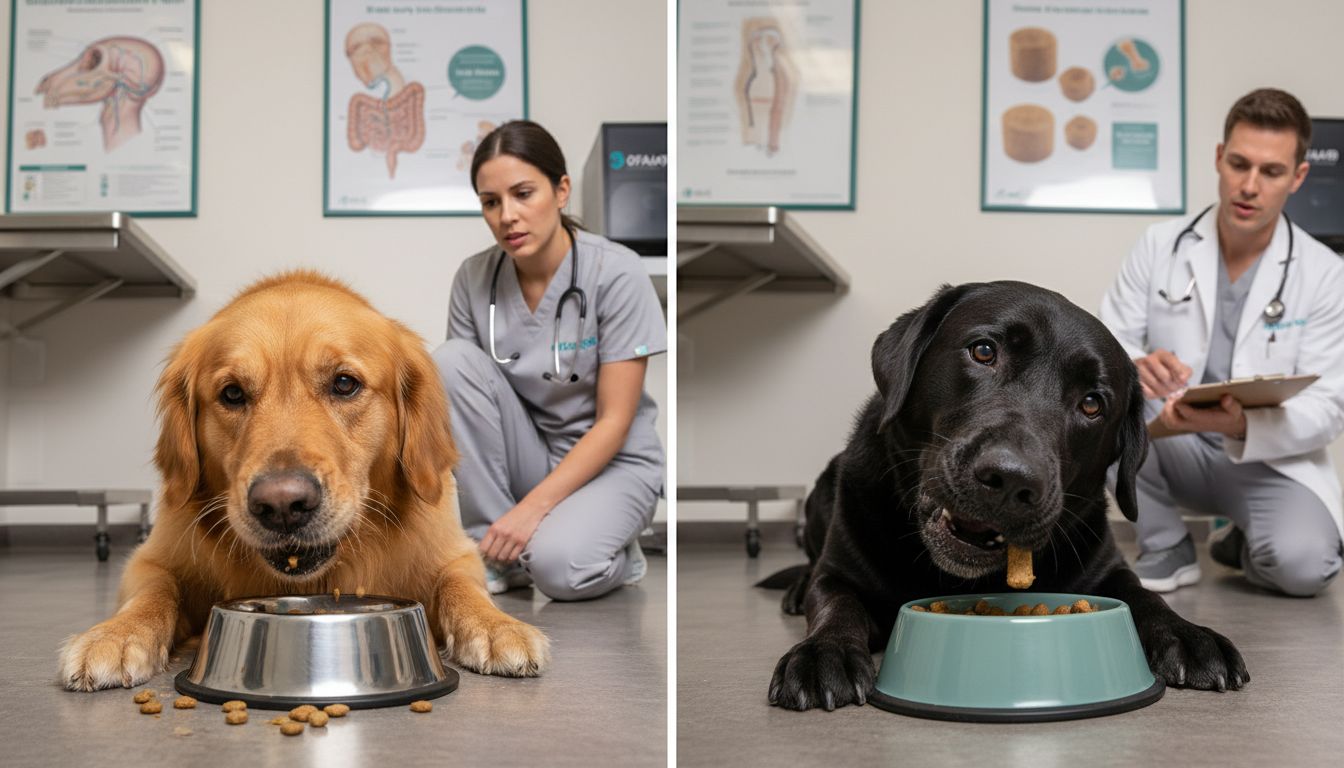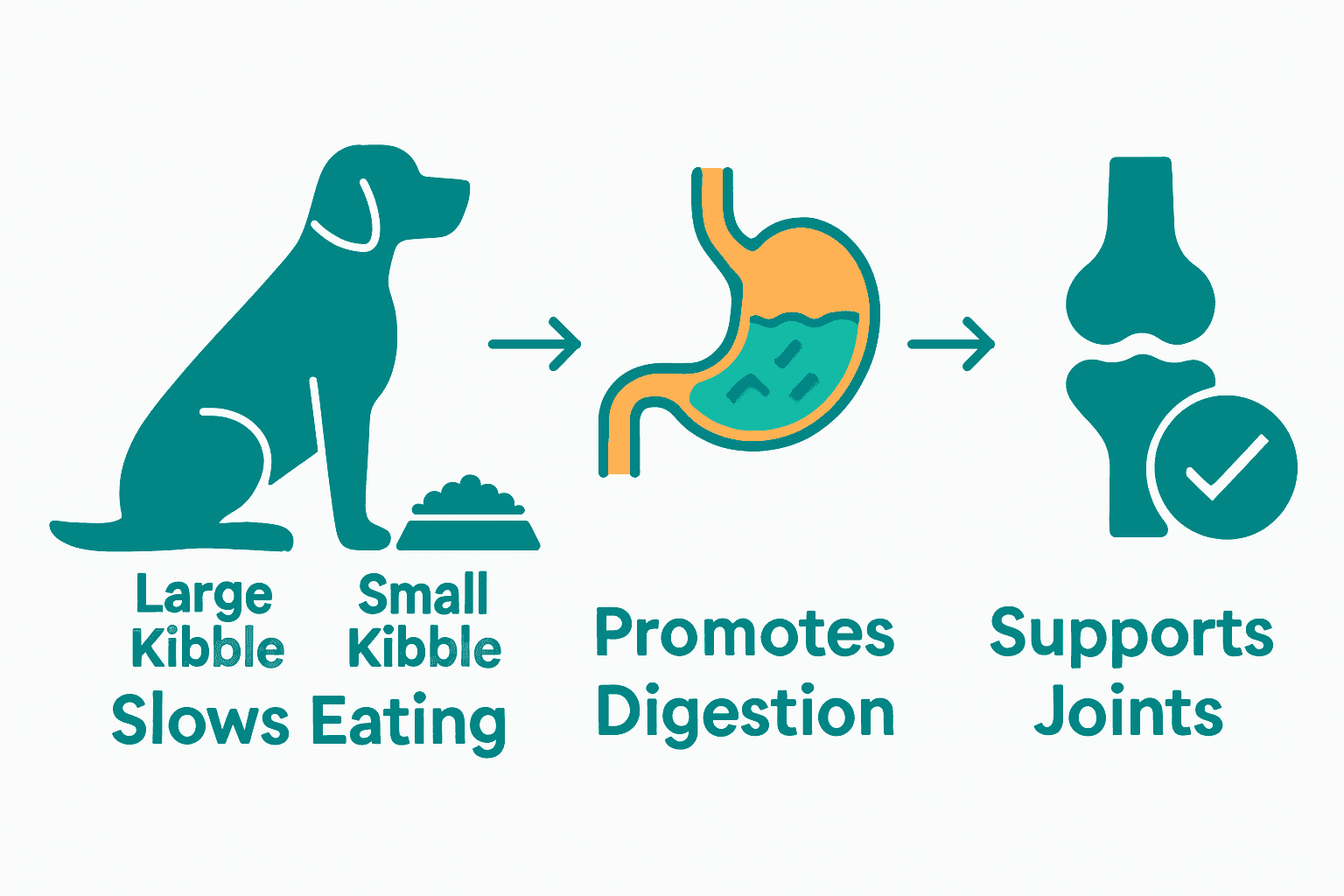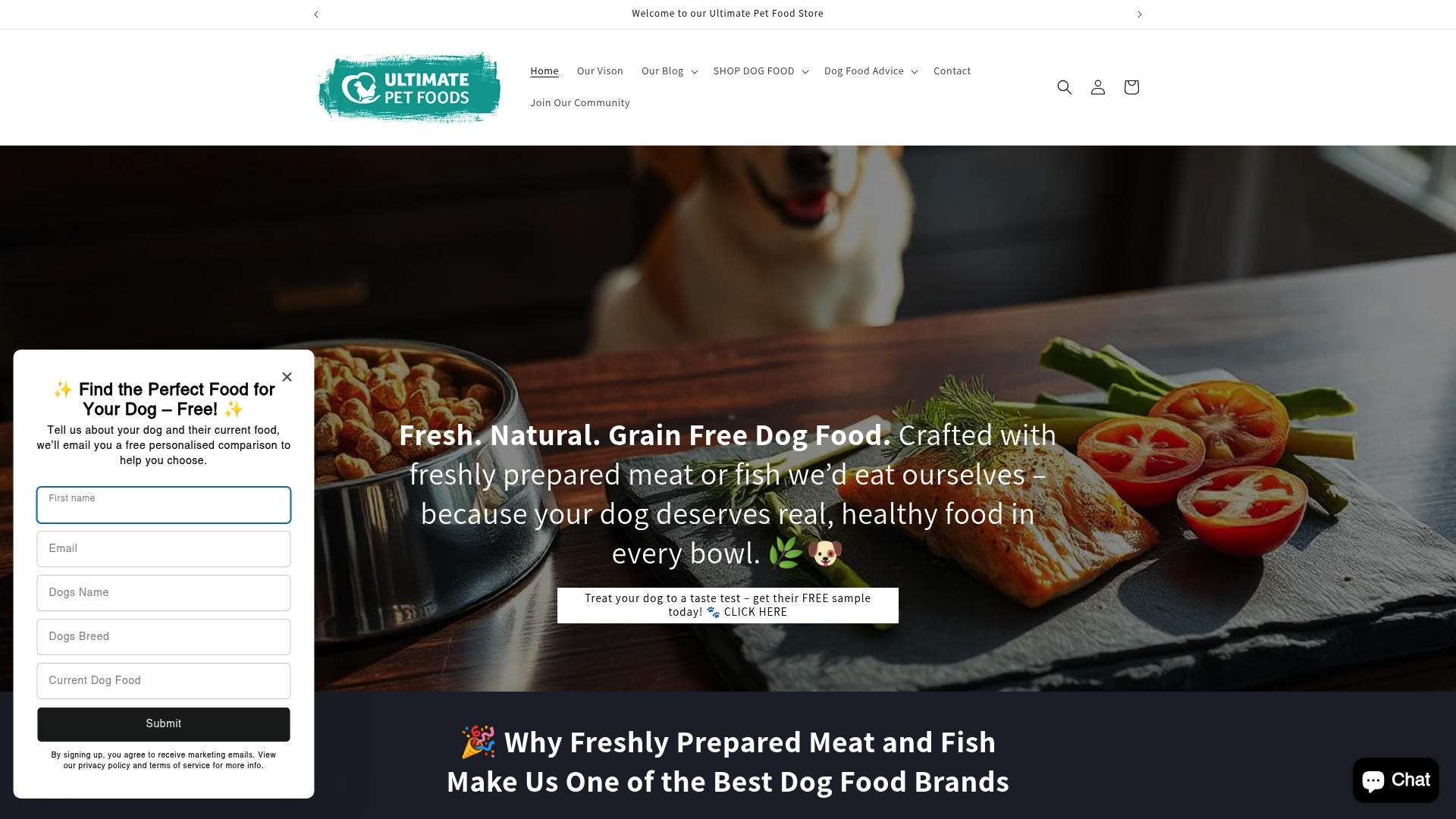
Complete Guide to Large Kibble Dog Food
Share
Some large dogs can eat their entire meal in less than a minute, which raises real concerns about digestion and joint health. The right food choice is about more than filling a bowl. Studies show that kibble designed for large breeds supports healthy chewing and reduces serious risks like bloat. Choosing large kibble tailored to your dog’s size can make a lasting difference in their daily comfort and long-term health.
Table of Contents
- What Is Large Kibble Dog Food?
- Key Benefits For Large Breeds
- Nutritional Standards And Ingredients
- Choosing The Right Kibble Size And Type
- Feeding Guidelines And Transitioning Tips
- Common Mistakes And Safety Precautions
Key Takeaways
| Point | Details |
|---|---|
| Specialized Nutrition | Large kibble dog food is tailored to meet the unique physiological needs of larger breeds, focusing on size, nutrient balance, and digestive health. |
| Feeding Practices | Optimal feeding for large breeds involves structured meal plans, slow feeding techniques, and ensuring consistent hydration. |
| Common Mistakes | Avoid overfeeding, inappropriate kibble sizes, and sudden diet changes to maintain your dog’s health and prevent complications. |
| Ingredient Quality | Choose kibble made from high-quality, human-grade ingredients that support joint health, metabolism, and overall wellness specific to large breeds. |
What Is Large Kibble Dog Food?
Large kibble dog food is a specialised nutrition option specifically designed for larger dog breeds, featuring strategically sized kibble pieces that provide more than just basic sustenance. According to PetMD, these diets are carefully crafted to address the unique nutritional requirements of large and giant breed dogs, with kibble sizes deliberately engineered to encourage thorough chewing and support digestive health.
The primary distinguishing feature of large kibble dog food is its larger kibble size, which serves multiple critical purposes. As research from VCA Hospitals indicates, these bigger kibble pieces are specifically designed to:
- Slow down eating speed
- Promote more deliberate chewing
- Reduce risks of digestive issues like bloat
- Support proper nutrient absorption

Nutrritionally, large kibble dog food goes beyond just size considerations. These specialized diets typically incorporate targeted nutrients that support the metabolic and physiological needs of larger dog breeds. Key nutritional elements often include L-carnitine for metabolism support, balanced minerals for bone strength, glucosamine for joint health, and carefully managed fat content to help control calorie intake. Our freshly prepared kibble, gentle cooked at 82°C, locks in essential nutrients while providing human-grade ingredients that support optimal canine nutrition.
The design philosophy behind large kibble extends beyond mere feeding mechanics. By encouraging slower eating and more deliberate mastication, these foods help prevent common health challenges in larger breeds such as gastric dilatation-volvulus (bloat) and support overall digestive wellness. Understanding how kibble size impacts nutrition can help pet owners make more informed dietary choices for their canine companions.
Key Benefits for Large Breeds
Large breed dog food offers a strategic approach to nutrition specifically tailored to the unique physiological requirements of larger dogs. According to PetMD, these specialized diets provide carefully controlled nutrition to address the complex health challenges faced by larger canine breeds.
The primary nutritional benefits of large breed dog food include:
- Controlled Calorie Management: Preventing obesity through lower calorie density
- Joint Health Support: Incorporating nutrients like glucosamine and omega-3 fatty acids
- Digestive Wellness: Balanced fiber types for optimal gastrointestinal function
- Metabolic Support: Targeted nutrients to maintain healthy body composition
Research from VCA Hospitals highlights that larger dog breeds have specific nutritional needs that differ significantly from smaller breeds. These specialized diets help mitigate common health risks such as joint deterioration, weight-related complications, and metabolic challenges.
 Our freshly prepared kibble, gentle cooked at 82°C, ensures that essential nutrients are locked in while providing human-grade ingredients that support comprehensive canine nutrition.
Our freshly prepared kibble, gentle cooked at 82°C, ensures that essential nutrients are locked in while providing human-grade ingredients that support comprehensive canine nutrition.
Understanding breed-specific nutritional requirements is crucial for responsible pet ownership. Understanding life stage dog nutrition can provide additional insights into how dietary needs evolve throughout your large breed dog’s life, ensuring optimal health and longevity.
Nutritional Standards and Ingredients
Nutritional standards for large breed dog food represent a sophisticated approach to canine nutrition, meticulously designed to address the unique physiological requirements of larger dogs. According to VCA Hospitals, these specialized nutritional standards focus on precise nutritional balance that supports overall health and prevents breed-specific challenges.
Key nutritional components in large breed dog food include:
- Protein Quality: High-protein content from fresh, human-grade sources
- Fat Management: Lower fat percentages to control calorie intake
- Joint Support Nutrients: Glucosamine and omega-3 fatty acids
- Specialized Fiber Blends: Targeted digestive health support
- Mineral Balance: Carefully proportioned calcium and phosphorus levels
Our freshly prepared kibble goes beyond standard nutritional requirements by incorporating gentle cooking techniques at 82°C, which preserves essential nutrients while ensuring maximum digestibility. The carefully selected ingredients are designed to provide comprehensive nutrition, supporting metabolic functions, joint health, and overall wellness specific to large breed dogs.
Understanding natural dog food ingredients can provide deeper insights into how precise nutritional formulations contribute to your large breed dog’s long-term health and vitality. By prioritizing high-quality, scientifically balanced ingredients, pet owners can make informed decisions that support their canine companions’ unique nutritional needs.
Choosing the Right Kibble Size and Type
Selecting the appropriate kibble size and type is a critical decision for large breed dog owners that goes far beyond simple feeding preferences. According to PetMD, the right kibble can significantly impact your dog’s digestive health, metabolism, and overall nutritional intake.
Key considerations when choosing kibble size and type include:
- Chewing Mechanics: Larger kibbles that encourage deliberate eating
- Digestive Health: Kibble design that promotes proper mastication
- Nutritional Density: Balanced nutrients tailored to large breed requirements
- Metabolic Support: Ingredients like L-carnitine for optimal energy processing
- Portion Control: Kibble size that helps manage calorie intake
Research from VCA Hospitals emphasizes that kibble type should strategically address large breed-specific nutritional challenges. Our freshly prepared kibble, gentle cooked at 82°C, is meticulously designed to provide larger pieces that slow down eating, reduce bloat risk, and support comprehensive nutritional needs. The carefully selected kibble size ensures dogs cannot gulp food quickly, promoting better digestion and nutrient absorption.
Dog food types and nutrition selection can provide additional insights into making informed kibble choices. By understanding the intricate relationship between kibble size, nutritional content, and your dog’s specific physiological requirements, you can make a diet decision that supports long-term health and vitality.
Feeding Guidelines and Transitioning Tips
Feeding large breed dogs requires a strategic and thoughtful approach to nutrition and diet management. According to PetMD, optimal feeding practices for large breed dogs involve carefully structured meal plans that address their unique physiological requirements and potential health challenges.
Key feeding guidelines for large breed dogs include:
- Meal Frequency: Divide daily food intake into 2-3 smaller meals
- Portion Control: Measure precisely to prevent overfeeding
- Consistent Timing: Establish regular feeding schedule
- Slow Feeding: Use techniques that prevent rapid consumption
- Hydration: Ensure constant access to fresh water
Research from VCA Hospitals emphasizes the importance of a gradual diet transition to prevent digestive complications. Our freshly prepared kibble, gentle cooked at 82°C, facilitates a smoother dietary change. The recommended transition process involves mixing increasing proportions of new food with the existing diet over 7-10 days, allowing your dog’s digestive system to adapt seamlessly.
Expert tips for transitioning dog foods successfully can provide additional guidance for pet owners navigating dietary changes. By approaching nutritional transitions with patience and understanding, you can ensure your large breed dog receives optimal nutrition while maintaining digestive comfort and overall health.
Common Mistakes and Safety Precautions
Navigating the nutritional landscape for large breed dogs requires careful attention and strategic planning. According to PetMD, many pet owners unknowingly make critical mistakes that can significantly impact their large breed dog’s health and well-being.
Common feeding mistakes for large breed dogs include:
- Overfeeding: Providing excessive calories leading to rapid weight gain
- Inappropriate Kibble Size: Using kibbles that don’t support proper chewing
- Inconsistent Feeding Schedule: Disrupting metabolic regularity
- Neglecting Nutrient Balance: Overlooking specific large breed nutritional needs
- Rapid Diet Changes: Implementing sudden dietary transitions
Research from VCA Hospitals emphasizes the importance of safety precautions in large breed nutrition. Our freshly prepared kibble, gentle cooked at 82°C, is meticulously designed to mitigate these risks by providing carefully portioned, nutrient-dense meals that support controlled calorie intake and optimal digestion. Safety measures include selecting diets with appropriate fiber types, joint-supporting nutrients, and portion-controlled kibble sizes that prevent rapid eating and reduce bloat risks.
How to read dog food ingredients can provide additional insights into making informed nutritional choices. By understanding these potential pitfalls and implementing careful feeding strategies, pet owners can ensure their large breed dogs maintain optimal health and prevent nutrition-related complications.
Give Your Large Breed the Nutrition They Deserve
Feeding a large breed dog the right kibble size and nutrients is essential to support joint health, digestion, and controlled calorie intake. If you are looking to prevent common issues like bloat and ensure your dog enjoys slower, more deliberate eating, choosing a specialised, natural food made with fresh ingredients is the key. Ultimate Pet Foods offers Chicken Dog Food : Healthy & Natural | Ultimate Pet Foods carefully formulated with large kibble size options that lock in nutrients using gentle cooking methods, perfectly crafted for bigger breeds.

Take control of your dog’s health today by exploring our grain-free, human-grade recipes tailored for all life stages. Visit Ultimate Pet Foods now to find the ideal food that matches your large dog’s unique needs and sample the quality difference yourself. For growing dogs, also consider our Try Our Grain Free Puppy Food - Optimal Health & Nutrition for early dietary support. Your canine companion’s wellbeing deserves nothing less.
Frequently Asked Questions
What is large kibble dog food?
Large kibble dog food is a specialized nutrition option designed for larger dog breeds, featuring larger kibble pieces that promote thorough chewing and support digestive health.
What are the benefits of feeding my large breed dog large kibble food?
Feeding large kibble food helps slow down eating, promotes better chewing, reduces risks of digestive issues like bloat, and supports specific nutritional needs such as joint health and controlled calorie intake.
How should I choose the right kibble size for my large breed dog?
The right kibble size for large breed dogs should encourage slow eating, support proper digestion, and contain balanced nutrients tailored to their specific needs, including larger pieces that facilitate proper mastication.
What feeding guidelines should I follow for my large breed dog?
Feed large breed dogs 2-3 smaller meals daily, control portions to prevent overfeeding, maintain a consistent feeding schedule, and ensure access to fresh water. Gradual dietary transitions are also recommended to avoid digestive upset.
